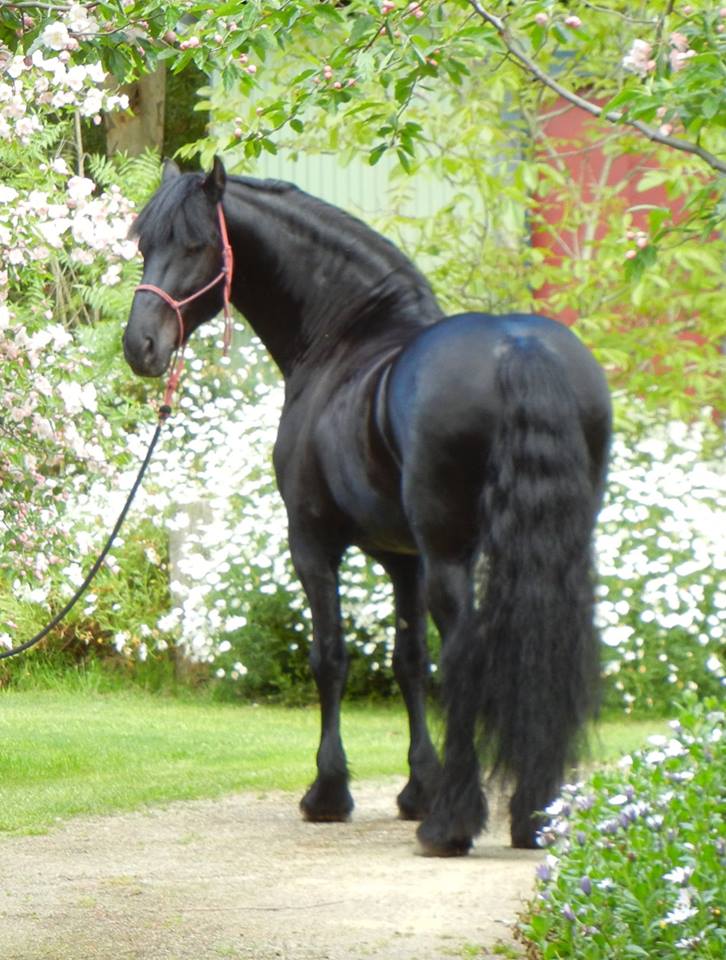
RARE BREEDS TRUST OF AUSTRALIA
powered by TidyHQHorses : FRIESIAN
Horses : FRIESIAN
Origin: Friesland, Netherlands
Australian Status: 
International Status:
Arrived in Australia: 1977
Australian Population: 400 total - 2017
2022 numbers. On the AFHS website, link below, one stallion is listed, Bastiaan510; and four Foalbook stallions with a permit, and the straws of another stallion. So that is six males.
Estimate three hundred mares. AFHS kindly answered census query, with an estimate of thirty six mares, as 36 foals had been registered in the past year. This has put the breed from "At Risk" to "Critical" on the Watch list. There are doubtless more breeding age mares, as an earlier estimate had them at about 300, so any help appreciated; however, a good reason to keep stock registered otherwise they're lost to the breed. It's possible some mares are not registered.
48 breeders spread about six states are listed.
If you're able to assist with accurate breeding age mare numbers, please contact our Equine Species Coordinator, Janet Lane, rarebreeds.equine@gmail.com
HIstory: It's thought powerful horses used by the Romans in the area of Holland-Germany-southern Denmark, were bred on by monks in the middle ages, and became useful for knights and those going on crusade. Jousting tournaments were the main form of entertainment for centuries - like football, tv and the internet now - the type used was the Friesian type. This strong, useful and good looking type was the most popular both at court and with anyone who had horses. Paintings from the 11th century on in Holland show the type. Weight carrying with good action (not low), sure footed, courageous, and with the heft to carry a charge through anything. When Spain occupied Holland 1568-1648 the influence of their Andalusian types further enhanced the horses of the Netherlands. The Friesian was one of the top breeds during the middle ages and used in turn to improve horses in other countries, such as the Oldenburg and other breeds in Prussia/Germany/Austria, England, Scandinavia and America in its colonial days. It's thought that grand old breed, the English Black, now extinct, owed much to the Friesian. This old Black line runs in many English breeds.
By the late nineteenth century only the wealthy farmers of Friesland still had the horses, they were used both harness and for ridden trotting races. A studbook was established, but heavier, steadier horses for farm work were preferred by most, the Friesian being more active and laughed at for being showy by most farmers. It became the work of a couple of dedicated families and one Royal stables to keep the breed going; all horses were also facing inexorable competition from mechanisation. Numbers got very low and the type smaller and heavier. Numbers however dwindled - in the mechanised era, with population increases; it was very expensive to keep a large horse that had no purpose. By the 1960's the situation was desperate. A band of the faithful staged a big public ride on their Friesians, in Holland; thus it gained a wonderful resurgence of support. The type bred back to how it was originally. Numbers increased rapidly, and the breed in now represented in many countries and has a healthy population in its homeland.
The breed is rigorously controlled by its Dutch organisation and its affiliates in other countries. For example there is no studbook stallion in Australia, although there are stallions which may be bred to. Several studbooks are kept to separate those meeting requirements of the Dutch governing body from those with less accreditation - the type is the same, it is simply separation by protocol regarding paperwork. The Society here will field questions for those uncertain of a horse's status, and have a good informative website.
Breed traits: A strong breed often called baroque for its old-fashioned good looks; all coloured a striking black. 15.1 hh minimum, most higher - the ideal height is 15.3hh at 3 years old. Upright neck carriage gives them a distinct profile; the neck is strong and arches at the crest. Full, luxurious mane and tail. Feathering. Powerful quarters. Deep through the girth with well-sprung ribs. Smallish ears slightly inwardly curved. Long straight or slightly convex nose; the head being described as noble.
Black. The only white permitted is a small star and a few white hairs around the muzzle. Occasionally a chestnut is seen, the chestnut gene is recessive as black has been the preferred colour.
Sloping croup of good length, not steep. Good temperament. A lively, willing breed. The strength for a sustained effort such as dressage. Action straight and true, with good suspension and impulsion.
Stands over its front legs well with the strong shoulder and powerful stance of a good riding horse, having strong forearms; the motor being in the hindquarters as it should be (not the motor in front as plough horse). This also frees up the wind. Breed congenital faults to be aware of are dwarfism and hydrocephalus, both of which can be genetically tested for; there is also a white factor, afterbirth retention and naval rupture to be looked out for. It was always said the breed is very inbred, as it got down to only a few stallions in the mid-twentieth century hence inbreeding occurred - however after that inbreeding was discouraged strongly, only 5% is allowed in a pedigree - commendable this ideal is strived for.
Uses : Jousting, dressage to haute ecole level, movies, circus, eventing, jumping, driving, hacking.
Breed Organisation:
Australian Friesian Horse Society established 1983. The AFHS is the official representative of the Royal Society “The Friesian Horse Studbook”, Koninklijke Vereniging Het Friesch Paarden Stamboek (KFPS), based in the Netherlands.
The global organisation is Koninklijke Vereniging Het Friesch Paarden Stamboek, in Holland https://www.kfps.nl/default.aspx established in 1879.
Additional Notes:
Photo : Gramayre Friesian Horse Stud, Australia, used with their kind permission
Page by Janet Lane.
Updated July 2022.
